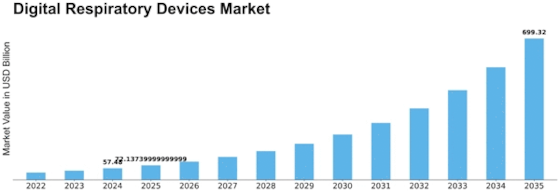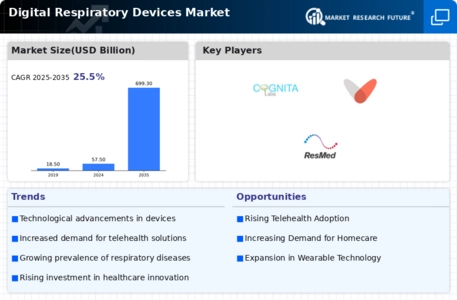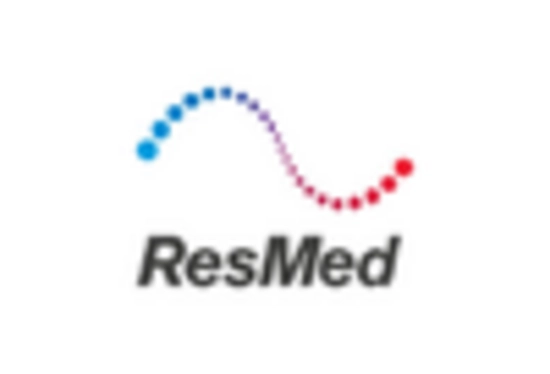-
EXECUTIVE SUMMARY
-
MARKET INTRODUCTION
-
Definition
-
Scope of the Study
- Research Objective
- Assumptions
- Limitations
-
RESEARCH METHODOLOGY
-
Overview
-
Data Mining
-
Secondary Research
-
Primary Research
- Primary Interviews and Information Gathering Process
- Breakdown of Primary Respondents
-
Forecasting Modality
-
Market Size Estimation
- Bottom-Up Approach
- Top-Down Approach
-
Data Triangulation
-
Validation
-
MARKET DYNAMICS
-
Overview
-
Drivers
-
Restraints
-
Opportunities
-
MARKET FACTOR ANALYSIS
-
Value Chain Analysis
-
Porter’s Five Forces Analysis
- Bargaining Power of Suppliers
- Bargaining Power of Buyers
- Threat of New Entrants
- Threat of Substitutes
- Intensity of Rivalry
-
COVID-19 Impact Analysis
- Market Impact Analysis
- Regional Impact
- Opportunity and Threat Analysis
-
GLOBAL DIGITAL RESPIRATORY DEVICES MARKET, BY PRODUCT
-
Overview
-
Smart Inhalers & Nebulizers
-
Sensors & Apps
-
GLOBAL DIGITAL RESPIRATORY DEVICES MARKET, BY INDICATION
-
Overview
-
Asthma
-
COPD
-
Other Diseases
-
GLOBAL DIGITAL RESPIRATORY DEVICES MARKET, BY DISTRIBUTION CHANNEL
-
Overview
-
Hospital Pharmacies
-
Retail Pharmacies
-
Online Pharmacies
-
GLOBAL DIGITAL RESPIRATORY DEVICES MARKET, BY END-USE
-
Overview
-
Hospitals
-
Homecare Settings
-
Other Settings
-
GLOBAL DIGITAL RESPIRATORY DEVICES MARKET, BY REGION
-
Overview
-
North America
- U.S.
- Canada
-
Europe
- Germany
- France
- U.K
- Italy
- Spain
- Rest of Europe
-
Asia-Pacific
- China
- India
- Japan
- South Korea
- Australia
- Rest of Asia-Pacific
-
Rest of the World
- Middle East
- Africa
- Latin America
-
COMPETITIVE LANDSCAPE
-
Overview
-
Competitive Analysis
-
Market Share Analysis
-
Major Growth Strategy in the Global Digital respiratory devices Market,
-
Competitive Benchmarking
-
Leading Players in Terms of Number of Developments in the Global Digital respiratory devices Market,
-
Key developments and Growth Strategies
- New Product Launch/Indication Distribution Channel
- Merger & Acquisitions
- Joint Ventures
-
Major Players Financial Matrix
- Sales & Operating Income, 2022
- Major Players R&D Expenditure. 2022
-
COMPANY PROFILES
-
COHERO HEALTH INC.
- Company Overview
- Financial Overview
- Products Offered
- Key Developments
- SWOT Analysis
- Key Strategies
-
Cognita Labs
- Company Overview
- Financial Overview
- Products Offered
- Key Developments
- SWOT Analysis
- Key Strategies
-
ADHERIUM LIMITED.
- Company Overview
- Financial Overview
- Products Offered
- Key Developments
- SWOT Analysis
- Key Strategies
-
Amiko Digital Health Limited
- Company Overview
- Financial Overview
- Products Offered
- Key Developments
- SWOT Analysis
- Key Strategies
-
Teva Pharmaceuticals Industries Ltd
- Company Overview
- Financial Overview
- Products Offered
- Key Developments
- SWOT Analysis
- Key Strategies
-
PROPELLER HEALTH.
- Company Overview
- Financial Overview
- Products Offered
- Key Developments
- SWOT Analysis
- Key Strategies
-
Novartis AG
- Company Overview
- Financial Overview
- Products Offered
- Key Developments
- SWOT Analysis
- Key Strategies
-
Pneuma Respiratory Inc.
- Company Overview
- Financial Overview
- Products Offered
- Key Developments
- SWOT Analysis
- Key Strategies
-
3M Health Care Limited
- Company Overview
- Financial Overview
- Products Offered
- Key Developments
- SWOT Analysis
- Key Strategies
-
AireHealth, Inc.
- Company Overview
- Financial Overview
- Products Offered
- Key Developments
- SWOT Analysis
- Key Strategies
-
FindAir Sp. z o.o.
- Company Overview
- Financial Overview
- Products Offered
- Key Developments
- SWOT Analysis
- Key Strategies
-
APPENDIX
-
References
-
Related Reports
-
-
LIST OF TABLES
-
GLOBAL DIGITAL RESPIRATORY DEVICES MARKET, SYNOPSIS, 2018-2032
-
GLOBAL DIGITAL RESPIRATORY DEVICES MARKET, ESTIMATES & FORECAST, 2018-2032 (USD BILLION)
-
GLOBAL DIGITAL RESPIRATORY DEVICES MARKET, BY PRODUCT, 2018-2032 (USD BILLION)
-
GLOBAL DIGITAL RESPIRATORY DEVICES MARKET, BY INDICATION, 2018-2032 (USD BILLION)
-
GLOBAL DIGITAL RESPIRATORY DEVICES MARKET, BY DISTRIBUTION CHANNEL, 2018-2032 (USD BILLION)
-
GLOBAL DIGITAL RESPIRATORY DEVICES MARKET, BY END-USE, 2018-2032 (USD BILLION)
-
NORTH AMERICA DIGITAL RESPIRATORY DEVICES MARKET, BY PRODUCT, 2018-2032 (USD BILLION)
-
NORTH AMERICA DIGITAL RESPIRATORY DEVICES MARKET, BY INDICATION, 2018-2032 (USD BILLION)
-
NORTH AMERICA DIGITAL RESPIRATORY DEVICES MARKET, BY DISTRIBUTION CHANNEL, 2018-2032 (USD BILLION)
-
NORTH AMERICA DIGITAL RESPIRATORY DEVICES MARKET, BY END-USE, 2018-2032 (USD BILLION)
-
NORTH AMERICA DIGITAL RESPIRATORY DEVICES MARKET, BY COUNTRY, 2018-2032 (USD BILLION)
-
U.S. DIGITAL RESPIRATORY DEVICES MARKET, BY PRODUCT, 2018-2032 (USD BILLION)
-
U.S. DIGITAL RESPIRATORY DEVICES MARKET, BY INDICATION, 2018-2032 (USD BILLION)
-
U.S. DIGITAL RESPIRATORY DEVICES MARKET, BY DISTRIBUTION CHANNEL, 2018-2032 (USD BILLION)
-
U.S. DIGITAL RESPIRATORY DEVICES MARKET, BY END-USE, 2018-2032 (USD BILLION)
-
CANADA DIGITAL RESPIRATORY DEVICES MARKET, BY PRODUCT, 2018-2032 (USD BILLION)
-
CANADA DIGITAL RESPIRATORY DEVICES MARKET, BY INDICATION, 2018-2032 (USD BILLION)
-
CANADA DIGITAL RESPIRATORY DEVICES MARKET, BY DISTRIBUTION CHANNEL, 2018-2032 (USD BILLION)
-
CANADA DIGITAL RESPIRATORY DEVICES MARKET, BY END-USE, 2018-2032 (USD BILLION)
-
EUROPE DIGITAL RESPIRATORY DEVICES MARKET, BY PRODUCT, 2018-2032 (USD BILLION)
-
EUROPE DIGITAL RESPIRATORY DEVICES MARKET, BY INDICATION, 2018-2032 (USD BILLION)
-
EUROPE DIGITAL RESPIRATORY DEVICES MARKET, BY DISTRIBUTION CHANNEL, 2018-2032 (USD BILLION)
-
EUROPE DIGITAL RESPIRATORY DEVICES MARKET, BY END-USE, 2018-2032 (USD BILLION)
-
EUROPE DIGITAL RESPIRATORY DEVICES MARKET, BY COUNTRY, 2018-2032 (USD BILLION)
-
GERMANY DIGITAL RESPIRATORY DEVICES MARKET, BY PRODUCT, 2018-2032 (USD BILLION)
-
GERMANY DIGITAL RESPIRATORY DEVICES MARKET, BY INDICATION, 2018-2032 (USD BILLION)
-
GERMANY DIGITAL RESPIRATORY DEVICES MARKET, BY DISTRIBUTION CHANNEL, 2018-2032 (USD BILLION)
-
GERMANY DIGITAL RESPIRATORY DEVICES MARKET, BY END-USE, 2018-2032 (USD BILLION)
-
FRANCE DIGITAL RESPIRATORY DEVICES MARKET, BY PRODUCT, 2018-2032 (USD BILLION)
-
FRANCE DIGITAL RESPIRATORY DEVICES MARKET, BY INDICATION, 2018-2032 (USD BILLION)
-
FRANCE DIGITAL RESPIRATORY DEVICES MARKET, BY DISTRIBUTION CHANNEL, 2018-2032 (USD BILLION)
-
FRANCE DIGITAL RESPIRATORY DEVICES MARKET, BY END-USE, 2018-2032 (USD BILLION)
-
ITALY DIGITAL RESPIRATORY DEVICES MARKET, BY PRODUCT, 2018-2032 (USD BILLION)
-
ITALY DIGITAL RESPIRATORY DEVICES MARKET, BY INDICATION, 2018-2032 (USD BILLION)
-
ITALY DIGITAL RESPIRATORY DEVICES MARKET, BY DISTRIBUTION CHANNEL, 2018-2032 (USD BILLION)
-
ITALY DIGITAL RESPIRATORY DEVICES MARKET, BY END-USE, 2018-2032 (USD BILLION)
-
SPAIN DIGITAL RESPIRATORY DEVICES MARKET, BY PRODUCT, 2018-2032 (USD BILLION)
-
SPAIN DIGITAL RESPIRATORY DEVICES MARKET, BY INDICATION, 2018-2032 (USD BILLION)
-
SPAIN DIGITAL RESPIRATORY DEVICES MARKET, BY DISTRIBUTION CHANNEL, 2018-2032 (USD BILLION)
-
SPAIN DIGITAL RESPIRATORY DEVICES MARKET, BY END-USE, 2018-2032 (USD BILLION)
-
U.K DIGITAL RESPIRATORY DEVICES MARKET, BY PRODUCT, 2018-2032 (USD BILLION)
-
U.K DIGITAL RESPIRATORY DEVICES MARKET, BY INDICATION, 2018-2032 (USD BILLION)
-
U.K DIGITAL RESPIRATORY DEVICES MARKET, BY DISTRIBUTION CHANNEL, 2018-2032 (USD BILLION)
-
U.K DIGITAL RESPIRATORY DEVICES MARKET, BY END-USE, 2018-2032 (USD BILLION)
-
REST OF EUROPE DIGITAL RESPIRATORY DEVICES MARKET, BY PRODUCT, 2018-2032 (USD BILLION)
-
REST OF EUROPE DIGITAL RESPIRATORY DEVICES MARKET, BY INDICATION, 2018-2032 (USD BILLION)
-
REST OF EUROPE DIGITAL RESPIRATORY DEVICES MARKET, BY DISTRIBUTION CHANNEL, 2018-2032 (USD BILLION)
-
REST OF EUROPE DIGITAL RESPIRATORY DEVICES MARKET, BY END-USE, 2018-2032 (USD BILLION)
-
ASIA PACIFIC DIGITAL RESPIRATORY DEVICES MARKET, BY PRODUCT, 2018-2032 (USD BILLION)
-
ASIA PACIFIC DIGITAL RESPIRATORY DEVICES MARKET, BY INDICATION, 2018-2032 (USD BILLION)
-
ASIA PACIFIC DIGITAL RESPIRATORY DEVICES MARKET, BY DISTRIBUTION CHANNEL, 2018-2032 (USD BILLION)
-
ASIA PACIFIC DIGITAL RESPIRATORY DEVICES MARKET, BY END-USE, 2018-2032 (USD BILLION)
-
ASIA PACIFIC DIGITAL RESPIRATORY DEVICES MARKET, BY COUNTRY, 2018-2032 (USD BILLION)
-
JAPAN DIGITAL RESPIRATORY DEVICES MARKET, BY PRODUCT, 2018-2032 (USD BILLION)
-
JAPAN DIGITAL RESPIRATORY DEVICES MARKET, BY INDICATION, 2018-2032 (USD BILLION)
-
JAPAN DIGITAL RESPIRATORY DEVICES MARKET, BY DISTRIBUTION CHANNEL, 2018-2032 (USD BILLION)
-
JAPAN DIGITAL RESPIRATORY DEVICES MARKET, BY END-USE, 2018-2032 (USD BILLION)
-
CHINA DIGITAL RESPIRATORY DEVICES MARKET, BY PRODUCT, 2018-2032 (USD BILLION)
-
CHINA DIGITAL RESPIRATORY DEVICES MARKET, BY INDICATION, 2018-2032 (USD BILLION)
-
CHINA DIGITAL RESPIRATORY DEVICES MARKET, BY DISTRIBUTION CHANNEL, 2018-2032 (USD BILLION)
-
CHINA DIGITAL RESPIRATORY DEVICES MARKET, BY END-USE, 2018-2032 (USD BILLION)
-
INDIA DIGITAL RESPIRATORY DEVICES MARKET, BY PRODUCT, 2018-2032 (USD BILLION)
-
INDIA DIGITAL RESPIRATORY DEVICES MARKET, BY INDICATION, 2018-2032 (USD BILLION)
-
INDIA DIGITAL RESPIRATORY DEVICES MARKET, BY DISTRIBUTION CHANNEL, 2018-2032 (USD BILLION)
-
INDIA DIGITAL RESPIRATORY DEVICES MARKET, BY END-USE, 2018-2032 (USD BILLION)
-
AUSTRALIA DIGITAL RESPIRATORY DEVICES MARKET, BY PRODUCT, 2018-2032 (USD BILLION)
-
AUSTRALIA DIGITAL RESPIRATORY DEVICES MARKET, BY INDICATION, 2018-2032 (USD BILLION)
-
AUSTRALIA DIGITAL RESPIRATORY DEVICES MARKET, BY DISTRIBUTION CHANNEL, 2018-2032 (USD BILLION)
-
AUSTRALIA DIGITAL RESPIRATORY DEVICES MARKET, BY END-USE, 2018-2032 (USD BILLION)
-
SOUTH KOREA DIGITAL RESPIRATORY DEVICES MARKET, BY PRODUCT, 2018-2032 (USD BILLION)
-
SOUTH KOREA DIGITAL RESPIRATORY DEVICES MARKET, BY INDICATION, 2018-2032 (USD BILLION)
-
SOUTH KOREA DIGITAL RESPIRATORY DEVICES MARKET, BY DISTRIBUTION CHANNEL, 2018-2032 (USD BILLION)
-
SOUTH KOREA DIGITAL RESPIRATORY DEVICES MARKET, BY END-USE, 2018-2032 (USD BILLION)
-
REST OF ASIA-PACIFIC DIGITAL RESPIRATORY DEVICES MARKET, BY PRODUCT, 2018-2032 (USD BILLION)
-
REST OF ASIA-PACIFIC DIGITAL RESPIRATORY DEVICES MARKET, BY INDICATION, 2018-2032 (USD BILLION)
-
REST OF ASIA-PACIFIC DIGITAL RESPIRATORY DEVICES MARKET, BY DISTRIBUTION CHANNEL, 2018-2032 (USD BILLION)
-
REST OF ASIA-PACIFIC DIGITAL RESPIRATORY DEVICES MARKET, BY END-USE, 2018-2032 (USD BILLION)
-
REST OF WORLD DIGITAL RESPIRATORY DEVICES MARKET, BY PRODUCT, 2018-2032 (USD BILLION)
-
REST OF WORLD DIGITAL RESPIRATORY DEVICES MARKET, BY INDICATION, 2018-2032 (USD BILLION)
-
REST OF WORLD DIGITAL RESPIRATORY DEVICES MARKET, BY DISTRIBUTION CHANNEL, 2018-2032 (USD BILLION)
-
REST OF WORLD DIGITAL RESPIRATORY DEVICES MARKET, BY END-USE, 2018-2032 (USD BILLION)
-
REST OF WORLD DIGITAL RESPIRATORY DEVICES MARKET, BY COUNTRY, 2018-2032 (USD BILLION)
-
MIDDLE EAST DIGITAL RESPIRATORY DEVICES MARKET, BY PRODUCT, 2018-2032 (USD BILLION)
-
MIDDLE EAST DIGITAL RESPIRATORY DEVICES MARKET, BY INDICATION, 2018-2032 (USD BILLION)
-
MIDDLE EAST DIGITAL RESPIRATORY DEVICES MARKET, BY DISTRIBUTION CHANNEL, 2018-2032 (USD BILLION)
-
MIDDLE EAST DIGITAL RESPIRATORY DEVICES MARKET, BY END-USE, 2018-2032 (USD BILLION)
-
AFRICA DIGITAL RESPIRATORY DEVICES MARKET, BY PRODUCT, 2018-2032 (USD BILLION)
-
AFRICA DIGITAL RESPIRATORY DEVICES MARKET, BY INDICATION, 2018-2032 (USD BILLION)
-
AFRICA DIGITAL RESPIRATORY DEVICES MARKET, BY DISTRIBUTION CHANNEL, 2018-2032 (USD BILLION)
-
AFRICA DIGITAL RESPIRATORY DEVICES MARKET, BY END-USE, 2018-2032 (USD BILLION)
-
LATIN AMERICA DIGITAL RESPIRATORY DEVICES MARKET, BY PRODUCT, 2018-2032 (USD BILLION)
-
LATIN AMERICA DIGITAL RESPIRATORY DEVICES MARKET, BY INDICATION, 2018-2032 (USD BILLION)
-
LATIN AMERICA DIGITAL RESPIRATORY DEVICES MARKET, BY DISTRIBUTION CHANNEL, 2018-2032 (USD BILLION)
-
LATIN AMERICA DIGITAL RESPIRATORY DEVICES MARKET, BY END-USE, 2018-2032 (USD BILLION)
-
-
LIST OF FIGURES
-
RESEARCH PROCESS
-
MARKET STRUCTURE FOR THE GLOBAL DIGITAL RESPIRATORY DEVICES MARKET
-
MARKET DYNAMICS FOR THE GLOBAL DIGITAL RESPIRATORY DEVICES MARKET
-
GLOBAL DIGITAL RESPIRATORY DEVICES MARKET, SHARE (%), BY PRODUCT, 2022
-
GLOBAL DIGITAL RESPIRATORY DEVICES MARKET, SHARE (%), BY INDICATION, 2022
-
GLOBAL DIGITAL RESPIRATORY DEVICES MARKET, SHARE (%), BY DISTRIBUTION CHANNEL, 2022
-
GLOBAL DIGITAL RESPIRATORY DEVICES MARKET, SHARE (%), BY END-USE, 2022
-
GLOBAL DIGITAL RESPIRATORY DEVICES MARKET, SHARE (%), BY REGION, 2022
-
NORTH AMERICA: DIGITAL RESPIRATORY DEVICES MARKET, SHARE (%), BY REGION, 2022
-
EUROPE: DIGITAL RESPIRATORY DEVICES MARKET, SHARE (%), BY REGION, 2022
-
ASIA-PACIFIC: DIGITAL RESPIRATORY DEVICES MARKET, SHARE (%), BY REGION, 2022
-
REST OF THE WORLD: DIGITAL RESPIRATORY DEVICES MARKET, SHARE (%), BY REGION, 2022
-
GLOBAL DIGITAL RESPIRATORY DEVICES MARKET: COMPANY SHARE ANALYSIS, 2022 (%)
-
COHERO HEALTH INC.: FINANCIAL OVERVIEW SNAPSHOT
-
COHERO HEALTH INC.: SWOT ANALYSIS
-
COGNITA LABS: FINANCIAL OVERVIEW SNAPSHOT
-
COGNITA LABS: SWOT ANALYSIS
-
ADHERIUM LIMITED.: FINANCIAL OVERVIEW SNAPSHOT
-
ADHERIUM LIMITED.: SWOT ANALYSIS
-
AMIKO DIGITAL HEALTH LIMITED: FINANCIAL OVERVIEW SNAPSHOT
-
AMIKO DIGITAL HEALTH LIMITED: SWOT ANALYSIS
-
TEVA PHARMACEUTICALS INDUSTRIES LTD.: FINANCIAL OVERVIEW SNAPSHOT
-
TEVA PHARMACEUTICALS INDUSTRIES LTD.: SWOT ANALYSIS
-
PROPELLER HEALTH.: FINANCIAL OVERVIEW SNAPSHOT
-
PROPELLER HEALTH.: SWOT ANALYSIS
-
NOVARTIS AG: FINANCIAL OVERVIEW SNAPSHOT
-
NOVARTIS AG: SWOT ANALYSIS
-
PNEUMA RESPIRATORY INC.: FINANCIAL OVERVIEW SNAPSHOT
-
PNEUMA RESPIRATORY INC.: SWOT ANALYSIS
-
3M HEALTH CARE LIMITED: FINANCIAL OVERVIEW SNAPSHOT
-
3M HEALTH CARE LIMITED: SWOT ANALYSIS
-
AIREHEALTH, INC.: FINANCIAL OVERVIEW SNAPSHOT
-
AIREHEALTH, INC.: SWOT ANALYSIS
-
FINDAIR SP. Z O.O: FINANCIAL OVERVIEW SNAPSHOT
-
FINDAIR SP. Z O.O: SWOT ANALYSIS










Leave a Comment